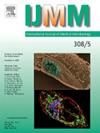Helicobacter pylori CagT4SS proteins CagN and CagM bind DNA and CagN is involved in heptose-independent pro-inflammatory substrate translocation by the T4SS
IF 3.6
3区 医学
Q1 MICROBIOLOGY
引用次数: 0
Abstract
The Cag type 4 secretion system (CagT4SS) of Helicobacter pylori is encoded on the cag pathogenicity island (cagPAI) that is present in about 60 % of all strains. It translocates the effector protein CagA, DNA and small bacterial metabolites into human cells. The transport mechanisms of these substrates are not clear and may involve Cag proteins still in search of a function. CagN is a partially surface-exposed CagT4SS protein with a poorly described function. The cagN gene is present in all cagPAI-positive strains and thus likely to be of importance and indispensable for the functionality of the T4SS. CagM is an essential structural component located within the outer membrane core complex of the CagT4SS in the bacterial outer membrane. CagM has a close genomic association and interacts directly with CagN. In this study, we addressed two questions on the basis of prior findings of T4SS-dependent DNA transport and TLR9 activation by H. pylori in host cells. First, we analyzed the role of CagN and CagM in the binding of the presumed CagT4SS substrate DNA. Second, we attempted to elucidate a presumed functional role of CagN in heptose-independent T4SS substrate translocation which may lead to pro-inflammatory activation in human cells. Using electrophoretic mobility shift assays (EMSA) and thermal shift assays (TSA), we found that both CagM and CagN interact with dsDNA. They can also act as nucleases and cleave DNA. Since the transport of substrates through the CagT4SS is likely ATP-driven, we also determined whether CagM and CagN can process ATP, which tested positive for both proteins. Co-incubating H. pylori with human TIFA-k/o cells, which no longer respond to the bacterial translocated effector heptose, but can still be activated by DNA, we established a phenotype of loss of heptose-independent pro-inflammatory activity with H. pylori cagN mutants that could be reversed by complementation. Our results propose an important role for CagN and CagM to bind DNA which might impact or be involved in the transport of substrates such as DNA, through the CagT4SS.
幽门螺杆菌CagT4SS蛋白CagN和CagM结合DNA, CagN参与T4SS介导的不依赖于肝脏的促炎底物易位
幽门螺杆菌的Cag 4型分泌系统(CagT4SS)编码在约60% %的菌株中存在的Cag致病性岛(cagPAI)上。它将效应蛋白CagA、DNA和小细菌代谢物转运到人体细胞中。这些底物的转运机制尚不清楚,可能涉及仍在寻找功能的Cag蛋白。CagN是一种部分表面暴露的CagT4SS蛋白,其功能描述甚少。cagN基因存在于所有cagpai阳性菌株中,因此可能对T4SS的功能至关重要和不可或缺。CagM是细菌外膜中CagT4SS外膜核心复合体内的重要结构成分。CagM与CagN有密切的基因组关联并直接相互作用。在这项研究中,我们基于先前发现的宿主细胞中t4ss依赖性DNA转运和幽门螺杆菌激活TLR9的两个问题。首先,我们分析了CagN和CagM在推测的CagT4SS底物DNA结合中的作用。其次,我们试图阐明CagN在heptos -independent T4SS底物易位中的假定功能作用,这可能导致人类细胞的促炎激活。通过电泳迁移率转移(EMSA)和热转移(TSA),我们发现CagM和CagN都与dsDNA相互作用。它们也可以作为核酸酶和切割DNA。由于底物通过CagT4SS的转运很可能是ATP驱动的,我们还确定了CagM和CagN是否可以处理ATP,这两种蛋白的检测结果均为阳性。将幽门螺杆菌与人TIFA-k/o细胞共孵育,这些细胞不再对细菌易位效应物庚糖产生反应,但仍然可以被DNA激活,我们建立了一种与幽门螺杆菌cagN突变体丧失不依赖于庚糖的促炎活性的表型,这种表型可以通过互补来逆转。我们的研究结果表明,CagN和CagM结合DNA可能影响或参与通过CagT4SS转运底物(如DNA)的重要作用。
本文章由计算机程序翻译,如有差异,请以英文原文为准。
求助全文
约1分钟内获得全文
求助全文
来源期刊
CiteScore
9.70
自引率
0.00%
发文量
18
审稿时长
45 days
期刊介绍:
Pathogen genome sequencing projects have provided a wealth of data that need to be set in context to pathogenicity and the outcome of infections. In addition, the interplay between a pathogen and its host cell has become increasingly important to understand and interfere with diseases caused by microbial pathogens. IJMM meets these needs by focussing on genome and proteome analyses, studies dealing with the molecular mechanisms of pathogenicity and the evolution of pathogenic agents, the interactions between pathogens and host cells ("cellular microbiology"), and molecular epidemiology. To help the reader keeping up with the rapidly evolving new findings in the field of medical microbiology, IJMM publishes original articles, case studies and topical, state-of-the-art mini-reviews in a well balanced fashion. All articles are strictly peer-reviewed. Important topics are reinforced by 2 special issues per year dedicated to a particular theme. Finally, at irregular intervals, current opinions on recent or future developments in medical microbiology are presented in an editorial section.

 求助内容:
求助内容: 应助结果提醒方式:
应助结果提醒方式:


